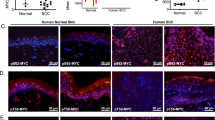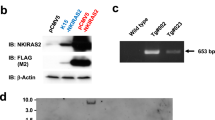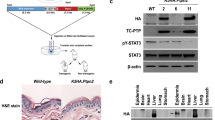Abstract
Myc and E2F1 can each stimulate proliferation, induce apoptosis, and contribute to oncogenic transformation. However, only E2F1 has been shown to have a tumor suppressive activity under some conditions. To examine the potential of Myc to suppress tumorigenesis under one of the conditions in which E2F1 functions to suppress tumorigenesis, transgenic mice expressing Myc under the control of a keratin 5 (K5) promoter were generated. Like K5 E2F1 transgenic mice, K5 Myc transgenic mice have hyperplastic and hyperproliferative epidermis and develop spontaneous tumors in the skin and oral epithelium. In addition, K5 Myc and K5 E2F1 transgenic mice both display aberrant, p53-dependent apoptosis in the epidermis. It has been demonstrated that deregulated expression of E2F1 in the epidermis of transgenic mice inhibits tumorigenesis in a two-stage skin carcinogenesis assay. In sharp contrast to those results, deregulated expression of Myc in the epidermis of transgenic mice resulted in an enhanced response to two-stage skin carcinogenesis. We conclude that while Myc and E2F1 have similar proliferative, apoptotic and oncogenic properties in mouse epidermis, Myc lacks E2F1's tumor suppressive property. This suggests that E2F1's unique ability to inhibit skin carcinogenesis is not simply a consequence of promoting p53-dependent apoptosis.
This is a preview of subscription content, access via your institution
Access options
Subscribe to this journal
Receive 50 print issues and online access
$259.00 per year
only $5.18 per issue
Buy this article
- Purchase on Springer Link
- Instant access to full article PDF
Prices may be subject to local taxes which are calculated during checkout






Similar content being viewed by others
References
Adams JM, Harris AW, Pinkert CA, Corcoran LM, Alexander WS, Cory S, Palmiter RD, Brinster RL . 1985 Nature 318: 533–538
Bello-Fernandez C, Packham G, Cleveland JL . 1993 Proc. Natl. Acad. Sci. USA 90: 7804–7808
Bouchard C, Thieke K, Maier A, Saffrich R, Hanley-Hyde J, Ansorge W, Reed S, Sicinski P, Bartek J, Eilers M . 1999 EMBO J 18: 5321–5333
Coller HA, Grandori C, Tamayo P, Colbert T, Lander ES, Eisenman RN, Golub TR . 2000 Proc. Natl. Acad. Sci. USA 97: 3260–3265
Conner EA, Lemmer ER, Omori M, Wirth PJ, Factor VM, Thorgeirsson, SS . 2000 Oncogene 19: 5054–5062
Conti CJ . 1994 Handbook of mouse mutations with skin and hair abnormalities. Sundberg JP (ed) CRC: Boca Raton pp 39–46
DeGregori J, Kowalik T, Nevins JR . 1995 Mol. Cell. Biol. 15: 4215–4224
DiGiovanni J . 1994 Carcinogenesis Target Organ Toxicology Series. Ward J and Waalkes MP (eds) Raven Press: New York pp 265–299
Elson A, Deng C, Campos-Torres J, Donehower LA, Leder P . 1995 Oncogene 11: 181–190
Field JK, Spandidos DA, Stell PM, Vaughan ED, Evan GI, Moore JP . 1989 Oncogene 4: 1463–1468
Fueyo J, Gomez-Manzano C, Yung WKA, Liu TJ, Alemany R, McDonnell TJ, Shi X, Rao JS, Levin VA, Kyritsis AP . 1998 Nature Med. 4: 685–690
Hermeking H, Eick D . 1994 Science 265: 2091–2093
Hiebert SW, Lipp M, Nevins JR . 1989 Proc. Natl. Acad. Sci. USA 86: 3594–3598
Hunt KK, Deng J, Liu T-J, Wilson-Heiner M, Swisher SG, Clayman G, Hung M-C . 1997 Cancer Res. 57: 4722–4726
Johnson DG . 2000 Mol. Carcinog. 27: 151–157
Johnson DG, Cress WD, Jakoi L, Nevins JR . 1994 Proc. Natl. Acad. Sci. USA 91: 12823–12827
Johnson DG, Schwarz JK, Cress WD, Nevins JR . 1993 Nature 365: 349–352
Kaczmarek L, Hyland JK, Watt R, Rosenberg M, Baserga R . 1985 Science 228: 1313–1315
Kowalik TF, DeGregori J, Leone G, Jakoi L, Nevins JR . 1998 Cell Growth Differ. 9: 113–118
Leone G, DeGregori J, Sears R, Jakoi L, Nevins JR . 1997 Nature 387: 422–426
McCormack SJ, Weaver Z, Deming S, Natarajan G, Torri J, Johnson MD, Liyanage M, Ried T, Dickson RB . 1998 Oncogene 16: 2755–2766
Merritt WD, Weissler MC, Turk BF, Gilmer TM . 1990 Arch. Otolaryngol.–Head Neck Surg. 116: 1394–1398
Pelengaris S, Littlewood T, Khan M, Elia G, Evan G . 1999 Mol. Cell 3: 565–577
Pena A, Reddy CD, Wu S, Hickok NJ, Reddy EP, Yumet G, Soprano DR, Soprano KJ . 1993 J. Biol. Chem. 268: 27277–27285
Pierce AM, Fischer SM, Conti CJ, Johnson DG . 1998a Oncogene 16: 1267–1276
Pierce AM, Gimenez-Conti IB, Schneider-Broussard R, Martinez LA, Conti CJ, Johnson DG . 1998b Proc. Natl. Acad. Sci. USA 95: 8858–8863
Pierce AM, Schneider-Broussard R, Gimenez-Conti IB, Russell JL, Conti CJ, Johnson DJ . 1999 Mol. Cell. Biol. 19: 6408–6414
Ramirez A, Bravo A, Jorcano JL, Vida M . 1994 Differentiation 58: 53–64
Rodriguez-Puebla ML, Robles AI, Johnson DG, LaCava M, Conti CJ . 1998 Cell Growth Differ. 9: 31–39
Sakamuro D, Eviner V, Elliott KJ, Showe L, White E, Prendergast GC . 1995 Oncogene 11: 2411–2418
Schmidt EV, Pattengale PK, Weir L, Leder P . 1988 Proc. Natl. Acad. Sci. USA 85: 6047–6051
Singh P, Wong S, Hong W . 1994 EMBO J. 13: 3329–3338
Stewart TA, Pattengale PK, Leder P . 1984 Cell 38: 627–637
Wagner AJ, Meyers C, Laimins LA, Hay N . 1993 Cell Growth Differ. 4: 879–883
Waikel RL, Wang XJ, Roop DR . 1999 Oncogene 18: 4870–4878
Wang A, Pierce AM, Judson-Kremer K, Gaddis S, Aldaz CM, Johnson DG, MacLeod MC . 1999 Nucleic Acids. Res. 27: 4609–4618
Wang A, Schneider-Broussard R, Kumar AP, MacLeod MC, Johnson DG . 2000a J. Biol. Chem. 275: 4532–4536
Wang D, Russell JL, Johnson DG . 2000b Mol. Cell. Biol. 20: 3417–3424
Wu X, Levine AJ . 1994 Proc. Natl. Acad. Sci. USA 91: 3602–3606
Xu G, Livingston DM, Krek W . 1995 Proc. Natl. Acad. Sci. USA 92: 1357–1361
Yamasaki L, Jacks T, Bronson R, Goillot E, Harlow E and Dyson NJ . 1996 Cell 85: 537–548
Acknowledgements
We thank Jen Philhower and Jen Smith for expert technical assistance, Shawnda Sanders for preparation of the manuscript, Lezlee Coghlan, Dale Weiss and coworkers for animal care, and Judy Ing and Chris Yone for artwork. We also thank Andy Butler for plasmids and other reagents. This work was supported by grants from the National Institutes of Health (CA79648 to DG Johnson, CA42157 to CJ Conti, NIEHS Center Grant ES007784, and M.D. Anderson Cancer Center Grant CA16672). This work was also supported by Tobacco Settlement Funds as appropriated by the Texas State Legislature.
Author information
Authors and Affiliations
Corresponding author
Rights and permissions
About this article
Cite this article
Rounbehler, R., Schneider-Broussard, R., Conti, C. et al. Myc lacks E2F1's ability to suppress skin carcinogenesis. Oncogene 20, 5341–5349 (2001). https://doi.org/10.1038/sj.onc.1204691
Received:
Revised:
Accepted:
Published:
Issue Date:
DOI: https://doi.org/10.1038/sj.onc.1204691
Keywords
This article is cited by
-
Opposing functions of Fbxw7 in keratinocyte growth, differentiation and skin tumorigenesis mediated through negative regulation of c-Myc and Notch
Oncogene (2013)
-
Myc, Aurora Kinase A, and mutant p53R172H co-operate in a mouse model of metastatic skin carcinoma
Oncogene (2012)
-
C/EBPα and β couple interfollicular keratinocyte proliferation arrest to commitment and terminal differentiation
Nature Cell Biology (2009)
-
MYC in mammalian epidermis: how can an oncogene stimulate differentiation?
Nature Reviews Cancer (2008)
-
E2F1 suppresses skin carcinogenesis via the ARF-p53 pathway
Oncogene (2006)



